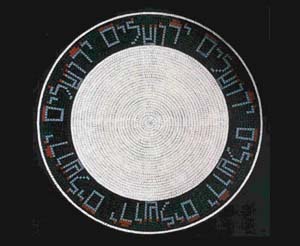Ziva Netanel executes a knitting piece in painting. She functions as a sub-knitter of sorts, instead of the mother, sister, friend or lover who identify at heart with the thoughts and ambitions of the potential male paramedic. Knitting a yarmulke for one’s sweetheart is an anachronistic residue of a traditionalist, ideological society with a clear-cut division of roles: the man goes out to war and the woman awaits him. The acts of knitting and embroidery enable women to express their hearts’ desires and support their lovers; this is their active contribution to the war effort. The active contribution that Netanel, a secular artist, can make to respond to the events is painting. Thus, while painting/knitting, she operates from a critical position. A closer look at the painting reveals that it does not imitate knitting, but rather simplifies the skullcap’s composition to a cross-hatch, employing the pattern forbidden for religious Jews – the cross – to generate defiance.
The patterns adorning the skullcap paintings were not conceived by the artist. Some were extracted from a pattern book (Gila Mas, The Book of Knitted Kipa, Carta/Cana Press, 1986, Hebrew); others were derived from a selection of existing skullcaps. Netanel translates them into painting “word for word,” closely following the book’s instructions. The basic unit of knitting provides a point of departure from where the knitted skullcap is formed. This is also where the subversive fabric knitted/painted by the artist originates.
The crystallizing beauty is but a luring trap of horror that gradually cumulates as the decorative embellishments begin to deviate from the realm of innocence to the realms of horror and violence, thus indirectly and subtly attesting to the transpiring events.
Less Reading...
